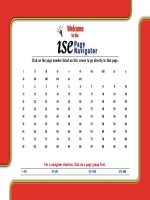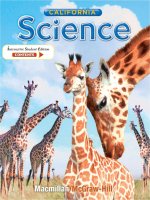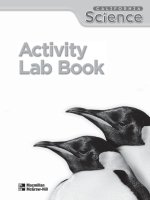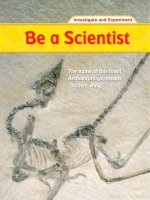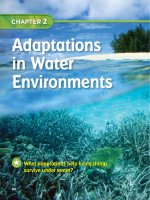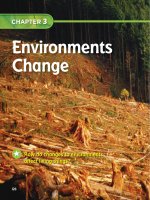- Trang chủ >>
- THPT Quốc Gia >>
- Hóa
California science grade 3 (1)
Bạn đang xem bản rút gọn của tài liệu. Xem và tải ngay bản đầy đủ của tài liệu tại đây (4.32 MB, 220 trang )
All photographs are by Macmillan/McGraw-Hill (MMH) except as noted below.
Cover Photos: (bkgd) Natural Selection Stock Photography; (inset) Pete Oxford/Steve Bloom Images/Alamy.
Science Content Standards for California Public Schools reproduced by permission, California Department of Education, CDE
Press, 1430 N Street, Suite 3207, Sacramento, CA 95814.
Published by Macmillan/McGraw-Hill, of McGraw-Hill Education, a division of The McGraw-Hill Companies, Inc.,
Two Penn Plaza, New York, New York 10121.
Copyright © by Macmillan/McGraw-Hill. All rights reserved. No part of this publication may be reproduced
or distributed in any form or by any means, or stored in a database or retrieval system, without the prior written consent
of The McGraw-Hill Companies, Inc., including, but not limited to, network storage or transmission, or broadcast for
distance learning.
Printed in the United States of America
1 2 3 4 5 6 7 8 9 024 09 08 07 06
A
Contents
LIFE SCIENCE
Chapter 1
Adaptations in Land Environments. . . . . . . . . . . . . . . . . . . . . . 1
Chapter 2
Adaptations in Water Environments . . . . . . . . . . . . . . . . . . . . 33
Chapter 3
Environments Change . . . . . . . . . . . . . . . . . . . . . . . . . . . . . . . . 53
EARTH SCIENCE
Chapter 4
Our Earth, Sun, and Moon . . . . . . . . . . . . . . . . . . . . . . . . . . . . 73
Chapter 5
The Solar System . . . . . . . . . . . . . . . . . . . . . . . . . . . . . . . . . . . . 93
PHYSICAL SCIENCE
Chapter 6
Matter . . . . . . . . . . . . . . . . . . . . . . . . . . . . . . . . . . . . . . . . . . . . .113
Chapter 7
Energy . . . . . . . . . . . . . . . . . . . . . . . . . . . . . . . . . . . . . . . . . . . . 133
Chapter 8
Light . . . . . . . . . . . . . . . . . . . . . . . . . . . . . . . . . . . . . . . . . . . . . . 153
Everyday Science Activities . . . . . . . . . . . . . . . . . . . . . . . . . . . . . . . . . . . . . 173
© Macmillan/McGraw-Hill
Learning Labs . . . . . . . . . . . . . . . . . . . . . . . . . . . . . . . . . . . . . . . . . . . . . . . . . 197
California science standards are noted at the top of activity pages. For the text of the
standards, please refer to the Reference section of the California Science Student Edition.
Activity Lab Book
iii
Name
Date
Explore
California Standard
3 IE 5.e.
What do plants need to live?
Form a Hypothesis
Do plants need light? Do they need water?
Write a hypothesis.
Materials
• 4 identical
plants
• measuring cup
and water
Test Your Hypothesis
Label four identical plants as shown.
Observe How do the plants look? Record your observations in
a chart.
Plants
Day 1
Day 4
Day 8
Day 12
Light and Water
Light and No Water
No Light and Water
© Macmillan / McGraw-Hill
No Light and No Water
!
Put the plants labeled No Light in a dark place. Put the plants
labeled Light in a sunny place. Water the plants labeled Water
every few days.
"
Predict What do you think will happen to each plant?
Chapter 1 • Adaptations in Land Environments
Activity Lab Book
Use with Lesson 1
Living Things and Their Needs
1
Explore
#
Name
Date
Collect Data Look at the plants every few days. Record your
observations in your chart.
Draw Conclusions
$
Analyze Data Which plant grew the most after two weeks?
Which plant looks the healthiest?
%
What do plants need to live?
Explore More
Experiment What else do plants need to live?
Inquiry: Open Think of your own question about what plants need to
live.
My question is:
© Macmillan / McGraw-Hill
How I can test it:
My results are:
2
Chapter 1 • Adaptations in Land Environments
Activity Lab Book
Use with Lesson 1
Living Things and Their Needs
Name
Alternative
Explore
Date
Picturing plant needs
Procedure
The first plant has received regular water and
sunlight. The second plant received regular
water but no sunlight. The last plant received
regular sunlight but no water.
Observe Describe how each plant looks.
Materials
• 3 plants or
photos of plants
that are the
same height
and type
Plant 1
Plant 2
Plant 3
© Macmillan / McGraw-Hill
Draw Conclusions What do plants need in order to live?
Chapter 1 • Adaptations in Land Environments
Activity Lab Book
Use with Lesson 1
Living Things and Their Needs
3
Quick Lab
Name
Date
Observe plant parts
Get two plants to observe.
Observe Look at the parts of each plant. Does each plant have
roots?
How about stems and leaves?
!
Record Data Use pictures and words to describe each plant’s
parts.
Plant
Roots
Stems
Leaves
Carrot
Basil
"
4
Compare How are the parts of these plants alike? How are they
different?
Chapter 1 • Adaptations in Land Environments
Activity Lab Book
Use with Lesson 1
Living Things and Their Needs
Name
Classify
Date
Focus on
Skills
California Standard
3 IE 5.e.
Earth is a big place. Millions of living things find homes in a wide
range of environments around our planet. With all these living
things and all these different environments, what can scientists do
to understand life in our world? One thing they do is compare and
classify living things and environments.
Learn It
When you classify, you put things into groups that are alike.
Classifying is a useful tool for organizing and analyzing things.
It is easier to study a few groups of things that are alike than
millions of individual things.
Try It
You learned that scientists classify Earth’s environments into
biomes. They classify animals, too. Can you?
To start you need to come up with a rule. What will you use for
grouping the animals shown on page 7? Let’s try wings.
Then use your rule to put the animals into groups. Which animals
have wings? Which animals do not? Make a T-chart to show your
groups.
Chapter 1 • Adaptations in Land Environments
Activity Lab Book
Use with Lesson 1
Living Things and Their Needs
5
Focus on
Skills
Name
No Wings
© Macmillan / McGraw-Hill
Wings
Date
6
Chapter 1 • Adaptations in Land Environments
Activity Lab Book
Use with Lesson 1
Living Things and Their Needs
Date
Focus on
Skills
© Macmillan / McGraw-Hill
Name
Chapter 1 • Adaptations in Land Environments
Activity Lab Book
Use with Lesson 1
Living Things and Their Needs
7
Focus on
Skills
!
Name
Date
Apply It
Classify these animals using a different rule.
No Tails
© Macmillan / McGraw-Hill
Tails
8
Chapter 1 • Adaptations in Land Environments
Activity Lab Book
Use with Lesson 1
Living Things and Their Needs
Name
Date
What adaptations help plants
survive in a desert?
Make a Prediction
Why can some plants live in dry
environments? How do special structures
help them survive? Write a prediction.
Explore
California Standard
3 IE 5.e.
Materials
• scissors
• two plants
• hand lens
Test Your Prediction
Observe Use a hand lens to observe each plant. What
structures do they have? What are their leaves like? What are
their stems like?
Record Data Make a chart to record your observations. Use
words and pictures.
Observe Cut a leaf from each plant in half. Use a hand lens to
look at the leaves. What are the leaves like inside?
© Macmillan / McGraw-Hill
!
Chapter 1 • Adaptations in Land Environments
Activity Lab Book
Use with Lesson 2
Life in the Desert
9
Explore
Name
Date
Draw Conclusions
"
Compare How are the plants alike? How are they different?
#
Infer What special structures help the desert plant survive in a
hot, dry environment?
Explore More
Experiment Put a leaf from each plant on the windowsill. How do the
leaves change?
Inquiry: Open Think of your own question about what desert plants
need to live.
My question is:
© Macmillan / McGraw-Hill
How I can test it:
My results are:
10
Chapter 1 • Adaptations in Land Environments
Activity Lab Book
Use with Lesson 2
Life in the Desert
Name
Date
Alternative
Explore
Which plant can survive
better in the desert?
Procedure
Record Data Look at the plants in the
photographs. Describe the leaves of the
two plants in a chart.
Materials
• photographs of
African violet
and jade plants
• paper towels
© Macmillan / McGraw-Hill
Make a Model Fold a paper towel in half so that you have two
layers. Fold another paper towel so that you have eight layers.
Wet both paper towels.
!
Observe Place both paper towels in a sunny window for an
hour. Describe your observations.
"
Compare Which paper towel is like the leaves of an African
violet plant? Which paper towel is like the leaves of the jade
plant?
#
Draw Conclusions Which plant will survive better in the desert?
How does this plant’s leaves help it survive?
Chapter 1 • Adaptations in Land Environments
Activity Lab Book
Use with Lesson 2
Life in the Desert
11
Quick Lab
Name
Date
Desert adaptations
Make a Model Wet two paper towels. Then wrap one in
wax paper. This models a plant that has waxy skin. Use the
uncovered towel to model a plant that does not have waxy skin.
Place your models in a sunny window.
Compare How do the paper towels feel later in the day?
"
Draw Conclusions How does waxy skin help desert plants
survive?
© Macmillan / McGraw-Hill
!
12
Chapter 1 • Adaptations in Land Environments
Activity Lab Book
Use with Lesson 2
Life in the Desert
Name
Be a
Scientist
Date
California Standard
3 IE 5.c., 3 IE 5.e.
How does camouflage help
some animals survive?
Materials
Form a Hypothesis
How does camouflage help animals stay safe?
Record your hypothesis. Start with “If an
animal has camouflage, then . . .”
• yellow paper
• brown paper
• stop watch
Test Your Hypothesis
Cut out 20 yellow circles and 20 brown circles.
Experiment Spread out the circles on the paper. Then ask a
classmate to pick up as many circles as he can in 10 seconds.
!
Record Data How many of each color circle did your classmate
pick up? Use a chart to record the results.
© Macmillan / McGraw-Hill
Classmate’s Name
Yellow Circles
Brown Circles
Repeat steps 1 and 2 with two other classmates.
Chapter 1 • Adaptations in Land Environments
Activity Lab Book
Use with Lesson 2
Life in the Desert
13
Be a
Scientist
Name
Date
Draw Conclusions
Analyze Data Did your classmates pick up more yellow or
brown circles? Which circles were harder to find?
#
How might camouflage help animals survive?
© Macmillan / McGraw-Hill
"
14
Chapter 1 • Adaptations in Land Environments
Activity Lab Book
Use with Lesson 2
Life in the Desert
Name
Date
Ba a
Scientist
How do pale colors help
some animals survive?
Form a Hypothesis
Pale body coverings help desert animals stay
cool. Why is this true? Write a hypothesis.
Materials
• white beans
• black beans
• two
thermometers
Test Your Hypothesis
Design a plan to test your hypothesis. Use the materials shown.
Write the steps you plan to follow.
!
"
Draw Conclusions
© Macmillan / McGraw-Hill
Did your results support your hypothesis? Why or why not? Share
your results with your classmates.
Chapter 1 • Adaptations in Land Environments
Activity Lab Book
Use with Lesson 2
Life in the Desert
15
Be a
Scientist
Name
Date
Inquiry: Open What other questions do you have about desert plants
and animals? Talk with your classmates about questions you have.
How might you find the answers to your questions?
Remember to follow the steps of the scientific process.
Ask a Question
Form a Hypothesis
Test Your Hypothesis
© Macmillan / McGraw-Hill
Draw Conclusions
16
Chapter 1 • Adaptations in Land Environments
Activity Lab Book
Use with Lesson 2
Life in the Desert
Name
Date
Why do some animals live
in a grassland?
Make a Prediction
Why do animals live in grassland? Write your
prediction.
Explore
California Standard
3 IE 5.d.
Materials
• index card
• markers or
pencils
• clear tape
Test Your Prediction
Use research materials to learn about an animal that lives in a
grassland biome.
© Macmillan / McGraw-Hill
Record Data Make a picture fact card for your animal. Draw
or tape a picture of the animal on the card and label it. On the
other side, write the name of the grassland biome and list the
three facts you learned.
Chapter 1 • Adaptations in Land Environments
Activity Lab Book
Use with Lesson 3
Life in the Grassland
17
Explore
Name
Date
Draw Conclusions
#
What are some important things that animals find in grassland
biomes?
Explore More
What would happen after a month of no rain in the grasslands? How
does rainfall affect grassland animals?
Inquiry: Open
My question is
How I can test it:
© Macmillan / McGraw-Hill
My results are:
18
Chapter 1 • Adaptations in Land Environments
Activity Lab Book
Use with Lesson 3
Life in the Grassland
Name
Date
Which adaptations allow
grassland animals to live
within their environment?
Procedure
Compare Sort animals by their
adaptations.
Alternative
Explore
Materials
• fact sheets
about grassland
animals
• encyclopedia/
Internet
© Macmillan / McGraw-Hill
Draw Conclusions
Chapter 1 • Adaptations in Land Environments
Activity Lab Book
Use with Lesson 3
Life in the Grassland
19
Quick Lab
Name
Date
How grasses grow
Put some sand or pebbles in the bottom
of a plastic cup. Add potting soil almost
to the top. Sprinkle grass seeds over the
soil. Water the soil. Place the cup in a
sunny spot.
Materials
• sand or pebbles
• potting soil
• grass seeds
Record Data Record when you planted
the grass on a calendar.
• paper cups
• water
!
Observe Check your grass seeds each
day. Keep the soil moist.
"
Compare Carefully uproot some grass. Measure the grass and
the roots. Which is longer?
© Macmillan / McGraw-Hill
• centimeter
rulers
20
Chapter 1 • Adaptations in Land Environments
Activity Lab Book
Use with Lesson 3
Life in the Grassland
Name
Date
Will a plant grow
toward light?
Explore
California Standard
3 IE 5.d.
Materials
Make a Prediction
Plants need sunlight to survive. If something
is blocking the light, how will a plant respond?
• scissors
• large shoebox
• heavy
cardboard
• masking tape
Test Your Prediction
• small potted
plant (fast
growing)
Cut a hole in one end of a shoe box.
Cut two dividers from the cardboard as
tall as the shoe box but an inch shorter than its width.
!
Tape the dividers upright along the inside of the box.
"
Put your plant in the end of the box opposite the hole. Then put
the lid on the box and turn the hole toward bright sunlight.
Draw Conclusions
© Macmillan / McGraw-Hill
How does the plant get the light it needs?
Chapter 1 • Adaptations in Land Environments
Activity Lab Book
Use with Lesson 4
Life in the Forest
21
Explore
Name
Date
Explore More
Observe Observe plants around your school. Are they getting direct
sunlight? Or are they in shade from a tree or building? How well have
they adapted to their environment?
Inquiry: Open Ask students to think about the other aspects of
their environment to which plants respond. Have them formulate a
question on this topic, then design and carry out an experiment to
answer it.
My question is:
How I can test it:
© Macmillan / McGraw-Hill
My results are:
22
Chapter 1 • Adaptations in Land Environments
Activity Lab Book
Use with Lesson 4
Life in the Forest

